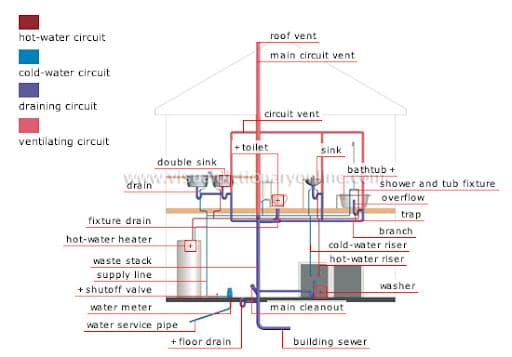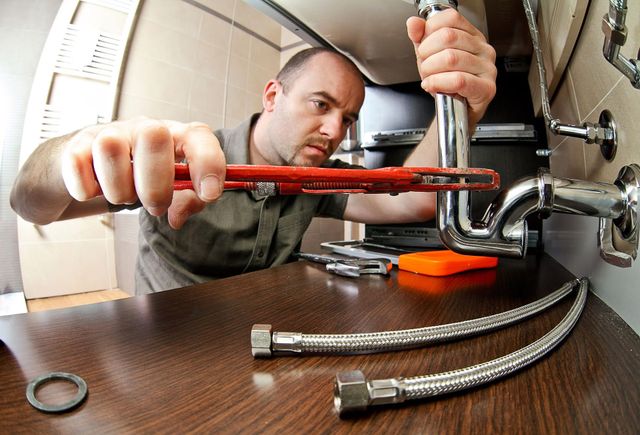Exploring The Structure of Your Home's Plumbing System
Exploring The Structure of Your Home's Plumbing System
Blog Article
Just about everyone has got his or her own idea with regards to Understanding Your Home's Plumbing Anatomy.

Comprehending just how your home's pipes system works is essential for each house owner. From delivering clean water for drinking, food preparation, and showering to securely eliminating wastewater, a well-maintained pipes system is essential for your family members's health and wellness and convenience. In this detailed guide, we'll discover the elaborate network that composes your home's pipes and offer ideas on maintenance, upgrades, and taking care of typical concerns.
Introduction
Your home's plumbing system is greater than simply a network of pipes; it's an intricate system that ensures you have access to clean water and reliable wastewater removal. Understanding its components and how they interact can help you stop costly repair work and make sure everything runs smoothly.
Standard Components of a Plumbing System
Pipelines and Tubing
At the heart of your pipes system are the pipes and tubes that bring water throughout your home. These can be constructed from various products such as copper, PVC, or PEX, each with its benefits in terms of toughness and cost-effectiveness.
Components: Sinks, Toilets, Showers, etc.
Components like sinks, commodes, showers, and bathtubs are where water is utilized in your house. Recognizing how these components connect to the plumbing system assists in detecting problems and preparing upgrades.
Valves and Shut-off Points
Shutoffs control the circulation of water in your plumbing system. Shut-off shutoffs are crucial throughout emergencies or when you require to make repairs, allowing you to isolate parts of the system without interrupting water circulation to the entire home.
Water System
Main Water Line
The primary water line connects your home to the community water or a private well. It's where water enters your home and is dispersed to numerous fixtures.
Water Meter and Pressure Regulatory Authority
The water meter steps your water usage, while a stress regulator guarantees that water streams at a safe pressure throughout your home's pipes system, avoiding damages to pipes and components.
Cold Water vs. Hot Water Lines
Recognizing the distinction between cold water lines, which provide water directly from the primary, and warm water lines, which bring heated water from the hot water heater, aids in repairing and preparing for upgrades.
Drainage System
Drain Pipes Water Lines and Traps
Drain pipes lug wastewater away from sinks, showers, and toilets to the sewage system or septic tank. Catches protect against drain gases from entering your home and also catch debris that could create blockages.
Air flow Pipes
Ventilation pipes permit air into the water drainage system, preventing suction that might slow drainage and cause catches to empty. Correct air flow is important for maintaining the honesty of your plumbing system.
Importance of Correct Drain
Guaranteeing correct drain stops back-ups and water damages. On a regular basis cleaning up drains and keeping traps can avoid pricey repair services and prolong the life of your plumbing system.
Water Heating Unit
Types of Hot Water Heater
Water heaters can be tankless or traditional tank-style. Tankless heating units warmth water on demand, while containers store heated water for prompt use.
Updating Your Pipes System
Reasons for Updating
Upgrading to water-efficient components or replacing old pipelines can enhance water quality, decrease water expenses, and boost the value of your home.
Modern Pipes Technologies and Their Benefits
Check out technologies like wise leakage detectors, water-saving bathrooms, and energy-efficient hot water heater that can save money and reduce environmental effect.
Cost Considerations and ROI
Compute the in advance prices versus long-term financial savings when considering plumbing upgrades. Several upgrades spend for themselves with lowered utility expenses and less repair work.
Just How Water Heaters Connect to the Plumbing System
Understanding how hot water heater link to both the cold water supply and warm water distribution lines assists in detecting issues like inadequate warm water or leaks.
Upkeep Tips for Water Heaters
Regularly flushing your hot water heater to get rid of debris, examining the temperature settings, and evaluating for leaks can expand its lifespan and boost energy effectiveness.
Common Plumbing Concerns
Leaks and Their Reasons
Leaks can take place due to maturing pipes, loose installations, or high water pressure. Attending to leaks immediately protects against water damages and mold development.
Clogs and Clogs
Obstructions in drains pipes and commodes are typically caused by flushing non-flushable things or a buildup of grease and hair. Using drainpipe displays and bearing in mind what goes down your drains can stop blockages.
Indicators of Plumbing Issues to Look For
Low tide stress, slow-moving drains, foul odors, or uncommonly high water costs are indicators of prospective plumbing problems that should be dealt with quickly.
Plumbing Upkeep Tips
Normal Assessments and Checks
Set up annual pipes assessments to catch problems early. Search for signs of leaks, rust, or mineral accumulation in faucets and showerheads.
DIY Maintenance Tasks
Straightforward jobs like cleaning faucet aerators, looking for bathroom leakages using dye tablet computers, or insulating subjected pipes in chilly environments can prevent significant pipes issues.
When to Call a Professional Plumbing
Know when a plumbing problem calls for specialist expertise. Trying intricate fixings without correct expertise can cause even more damage and greater repair service prices.
Tips for Lowering Water Usage
Simple routines like fixing leakages quickly, taking much shorter showers, and running complete loads of laundry and meals can preserve water and lower your utility expenses.
Eco-Friendly Pipes Options
Consider sustainable pipes products like bamboo for floor covering, which is durable and green, or recycled glass for countertops.
Emergency Preparedness
Steps to Take During a Plumbing Emergency
Know where your shut-off shutoffs lie and just how to turn off the water in case of a ruptured pipe or major leak.
Importance of Having Emergency Get In Touches With Convenient
Maintain contact information for local plumbing technicians or emergency solutions conveniently offered for fast action throughout a pipes situation.
Ecological Influence and Conservation
Water-Saving Fixtures and Home Appliances
Mounting low-flow faucets, showerheads, and commodes can dramatically lower water use without sacrificing performance.
DIY Emergency Situation Fixes (When Relevant).
Short-lived solutions like using air duct tape to spot a dripping pipe or putting a container under a leaking faucet can minimize damages till a specialist plumbing professional gets here.
Verdict.
Recognizing the composition of your home's plumbing system encourages you to keep it successfully, saving time and money on repair work. By complying with routine upkeep routines and staying notified regarding modern plumbing technologies, you can ensure your plumbing system runs successfully for many years to find.
HOW YOUR PLUMBING SYSTEM WORKS
Which Pipes Do What?
Blue lines = fresh water supply entering the building Red lines = hot water supply entering the building Grey lines = pipes carrying waste away from the building and venting pipes carrying gases away from the building (through the roof) YOUR MAIN PLUMBING SYSTEMS
There are two main plumbing systems that support your home s basic plumbing needs one that brings clean water into your home, and one that sends dirty water away from your home. Connected to the toilet, bath, shower, and other faucets in your home, these two systems keep your water flowing in the right directions.
ACCESSING FRESH WATER
Fresh and clean water is brought into your home through the main water supply line . Filtered through one pipe, this water is pressured to flow into the various fixtures in your home at any given time.
This water can be sourced from a well located on your property, a pond or river (mostly cottages), or, as in most cases, from the city s municipal water treatment centre. However, it is important to note that water that is untreated, such as the water siphoned from ponds or rivers, may not be safe to drink. Personal water supplies always need to be treated for hardness and contaminants before consumed.
MUNICIPAL WATER SUPPLIES
Improve taste and odour Remove sediment Eliminate hardness Reduce chlorine COLD WATER SUPPLY VS. HOT WATER SUPPLY
Cold water flows into your home or building through the service line, which then distributes hot or cold water to your fixtures. This line is most commonly run through a central column that runs floor to floor. Hot water runs in short and straight pipes as the longer the pipeline, the more heat that will be lost in the transfer. Having shorter pipes also allows residents to access hot water more quickly.
WASTE WATER SYSTEM
Your wastewater system is divided into two parts pipes that send wastewater away from your home and venting pipes that send sewer gas away from your home. Sewage water travels through pipes that flush the water and waste towards local sewers that are operated and managed by your city or town. Most sewer systems rely on gravity to move the wastewater to where it needs to go.
The further away from your toilet or sink, the larger wastewater pipes become. This allows for waste to be disposed of from various parts of your home or business at once without pipe blockages. The angle and flow of these pipes are also essential for keeping your waste pipes clear of build up.
https://harrisplumbing.ca/how-your-home-plumbing-system-works/

We are very fascinated by Anatomy of a House: Understanding the Components and I hope you enjoyed reading the entry. Sharing is good. Who knows, you may just be helping someone out. I praise you for your time. Come back soon.
Get Estimate Report this page